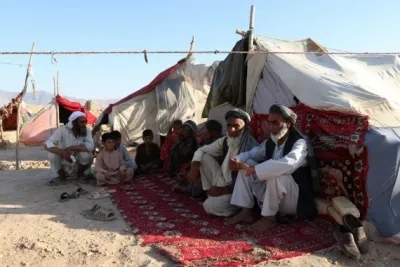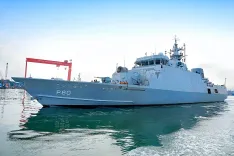Did the US Military Really Sink a Drug-Trafficking Vessel in the Pacific?

Synopsis
Key Takeaways
- US Military Actions: The US has intensified its military operations against drug trafficking.
- Loss of Life: Recent strikes have resulted in a significant death toll.
- International Relations: Tensions between the US and Colombia are escalating.
- Lack of Evidence: Claims of drug trafficking remain largely unsubstantiated.
- Survivors: The repatriation of survivors raises further questions about accountability.
Washington, Oct 23 (NationPress) The US military has sank its eighth alleged drug-trafficking vessel in international waters, marking the first such operation in the Pacific, resulting in the deaths of two individuals aboard, according to US Defence Secretary Pete Hegseth.
"Yesterday, under the orders of President Trump, the Department of War executed a lethal strike on a vessel operated by a Designated Terrorist Organisation engaged in narcotics trafficking in the Eastern Pacific," he stated on Wednesday via X.
Hegseth alleged that the vessel was transporting illicit drugs along a recognized drug-trafficking route, as reported by Xinhua News Agency.
"Just as Al Qaeda has attacked our homeland, these cartels are waging war against our borders and our citizens. There will be no sanctuary or clemency — only justice," he noted, labeling the deceased as narco-terrorists without providing evidence or naming the organization.
Hegseth confirmed that the strike was conducted in international waters.
Reports from a US media outlet indicated it occurred near the Pacific coast of Colombia.
The Pentagon had already carried out seven previous operations in the southern Caribbean international waters since September, primarily targeting vessels accused of transporting drugs from Venezuela to the US.
The cumulative death toll from recent US strikes against alleged drug-trafficking vessels has now reached at least 34 as of Wednesday.
Relations between the US and Colombia have deteriorated in recent times.
Earlier this month, Colombian President Gustavo Petro accused the Trump administration of committing murder for killing drug suspects at sea.
Trump retaliated by reducing US aid to Colombia while threatening to impose new tariffs on the South American nation.
Tuesday's attack has increased the confirmed death toll from Trump's bombing campaign to 34, based on official statements.
The airstrikes initiated on September 2, when Trump announced via his social media that he had ordered a kinetic strike that morning on a small boat navigating through international waters.
In that operation, eleven individuals — whom Trump referred to as terrorists — were killed. Their identities were not revealed, nor was any evidence provided regarding their intended destination or cargo.
"Let this serve as a warning to anyone contemplating drug trafficking into the United States," Trump remarked, accusing the passengers of the boat, without substantiation, of connections to the Venezuelan gang Tren de Aragua.
Subsequent strikes followed. On September 15, another operation occurred in the Caribbean, resulting in three fatalities. A third strike took place on September 19, also claiming three lives.
The bombing campaign extended into the next month. On October 3, Hegseth reported a new strike that resulted in the deaths of four people. Six additional individuals were killed on October 14.
The seventh documented strike, however, deviated from the Trump administration’s standard for announcing attacks.
Typically, Trump and his associates would be among the first to disclose strikes, sharing them on social media alongside grainy aerial footage.
However, on October 16, US media reported that a strike had occurred and that there were two survivors, a first in this context.
The Trump administration confirmed the strike a day later.
The survivors were promptly repatriated to their respective countries, Ecuador and Colombia.
Ecuador has since released its survivor, asserting there was no evidence linking him to any crime.
Yet, Trump reiterated, characterizing the men as being aboard what he termed a very large DRUG-CARRYING SUBMARINE.
He confirmed that two more individuals were killed in this attack.









